Growing zucchini in containers
How to grow zucchini in pots
If you’ve ever seen squash plants, you know they’re NOT small. While there are compact varieties ideal for growing zucchini in containers, most are big sprawling garden plants with long vines, large leaves, and big flowers.
So you might be surprised to learn you can successfully grow zucchini in pots on your deck or patio!
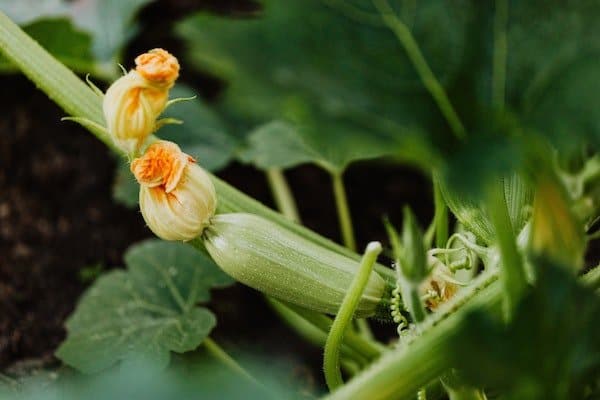
Zucchini is a summer squash variety known for big production. In the gardening world, it’s famous for overloading home growers with so much they have to drop off the overflow for the neighbors.
The first time I grew zucchini many years ago, it was in a big in-ground garden and It. Went. Everywhere. It didn’t do very well because I had minimal knowledge about optimal care and conditions … and not enough time to keep up with that huge garden in the first place.
I didn’t want to give up. We love zucchini in our house and it can produce like crazy with the right conditions.
I was so happy to discover zucchini squash CAN grow in pots and containers!
For one thing, it’s easier to step out the back door and keep a close eye on flowers and fruits once harvest begins. And added bonus … you can potentially avoid some pests like squash borers that overwinter in garden soil.
Keep reading to find out how to plant and care for zucchini in your container garden, when to harvest, companion plants for zucchini, and more.
TIP: Don’t miss the section on how to pollinate zucchini – it’s necessary for fruit to grow!
This post may contain affiliate links. If you buy something through these links, we may earn a small commission at no cost to you.
How to plant zucchini in pots
Zucchini is part of the cucurbit family, which also includes cucumbers, melons and pumpkins. While these tend to be big, viney plants, there are compact varieties that can thrive in containers.
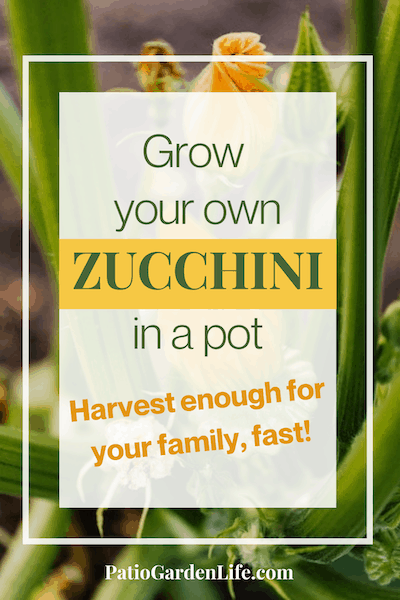
Start zucchini from seed
Zucchini isn’t hard to grow from seed. However, it’s pretty sensitive to frost and cold, so be sure to follow planting directions for the variety you choose.
- One or two weeks after your area’s last frost, plant 2-3 seeds in the pot you plan to use for the season. (Here’s a handy frost calculator if you’re not sure. To grow successfully, zucchini needs soil and air temperatures consistently over 60 degrees F.)
- Although zucchini does best when planted where it’s going to grow for the season, you can plant seeds indoors 2-3 weeks before last frost, to get a head start. To minimize root disruption, use biodegradable seed starters you can plant in the larger container when the time comes.
- Sow seeds 1 inch deep in a seed starting mix.
- Keep soil moist but not soggy.
- Seeds should germinate in 7-10 days.
- When seedlings have two sets of true leaves, thin to one plant. Thin by snipping the stems at the base of all but the strongest seedling.
Or start zucchini from seedlings
Seedlings allow you to start the process later in the season and skip the seed-starting process.
You can often find strong, healthy seedlings that are several weeks ahead of freshly planted seeds. Try farmers markets or a local nursery or garden store.
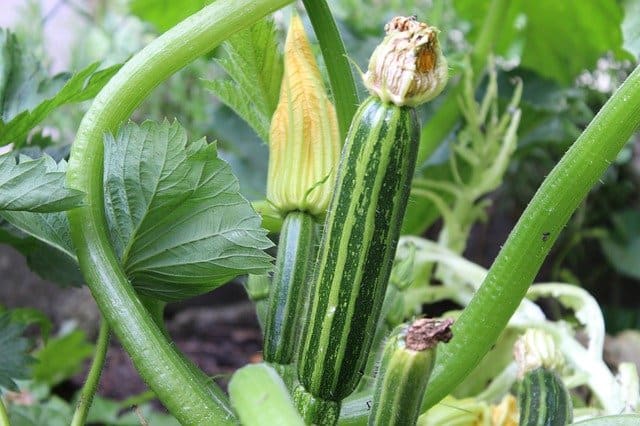
TIP: I’ve had the best luck finding good vegetable seedlings at the farmers market, where they’re often grown organically.
The grower can give you details about the variety and tips for transplanting and growing in your local climate.
Farmers markets are amazing. Find yours!
- To plant a zucchini seedling, dig a hole double the size of the root ball and carefully set the seedling inside. Pat soil around the base of the seedling.
- Water thoroughly. Keep soil lightly moist (but not soggy) daily until seedlings start to produce new growth.
- If you go with seedlings and they haven’t been hardened off (or you’re not sure they have been), gradually expose them to the outdoors before planting in your containers. This helps them adjust to direct sun and harsher conditions.
TIP: To harden, before you move them outside, cut back a bit on water and lower the temperature into the 60s F. Set them out in indirect sunlight for an hour or two per day for a few days, adding a bit more time and direct sunlight each day until they’re in full sun all day.
Best way to plant zucchini in pots
Choose a container and a VERY sunny spot
Zucchini likes: full sun, plenty of water, room to spread out
Zucchini doesn’t like: less than 8 hours of sun per day, soggy soil, small containers
These are all key factors when deciding where and how you’re going to plant.
Zucchini plants can grow 3-4 feet tall … even some compact varieties. And they need plenty of space for their root systems to develop.
Choose a large container like:
- A half barrel
- A 15-30 gallon fabric soft-sided planter
- A pot with at least a 20-inch diameter
- A large planter box
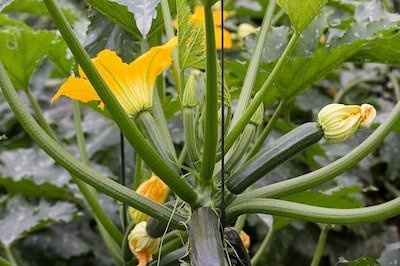
- Next, find a spot on your patio, deck or balcony that gets full sun at least 6-8 hours per day, preferably more. Zucchini loves sun and needs a lot of it to fuel big growth.
TIP: One of the best things about container gardening is the flexibility to move things around. If you don’t have one good spot that gets 8+ hours of sun per day, you could pick two spots for it. Start it where the morning and early afternoon sun is strongest, then move it mid-day to an afternoon spot.
- Once your container is settled, plant your seedlings or sow your seeds. Use good quality potting soil (not garden soil, which can carry pests and zucchini can be susceptible) and several scoops of aged compost or manure. Zucchini needs a lot of nutrients, so starting out with an extra boost will get you off to a good start.
Does zucchini need a trellis?
It depends on the variety, but in general, it’s not a bad idea to have stakes or a trellis available for your zucchini plant to climb. Especially if you have a tight space.
If you go that route, add the stakes or trellis when you plant the seeds or seedling. Adding them later can cause root damage.
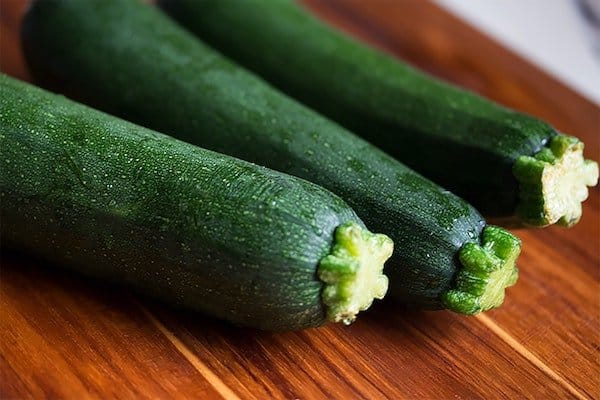
How to care for zucchini in pots
Watering instructions
Zucchini needs a lot of water, enough to keep the soil consistently moist (but not soggy). Aim for 1-2 inches per week, more if it’s hot and dry. If the soil is dry to the touch for the top couple of inches, go ahead and water.
This most likely means daily watering, so stay on top of it! (Set a reminder for yourself if need be. I literally set myself reminders for everything … that’s why smartphones were invented, right?)
TIP: Like with most plants, zucchini does better with thorough watering on the right timing, rather than occasional shallow watering.
Mulch can help maintain moisture levels. Consider adding a layer of organic mulch like straw or coco fiber (made from coconut husks) to the top of your soil.
Fertilizer instructions
Considering how much zucchini grows and produces, it’s a good idea to feed it some fertilizer throughout the growing season. I like adding some slow-release fertilizer pellets when I first plant zucchini, to ensure at least a low level of fertilizer over the growing cycle. If you’re using high-quality potting soil, you’ll get a little boost from that as well.
Then go for monthly applications of an all-purpose, water-soluble fertilizer or consider side dressing with aged compost every 6 weeks or so.
You could also try monthly doses of compost tea if you have a compost bin. (Compost tea is easy to make and has a lot of benefits for vegetable plants with high nutrient needs!)
Zucchini pollination: Super important!
Zucchini plants grow two types of flowers: female and male. Pollination is necessary for the female flowers to produce the fruit.
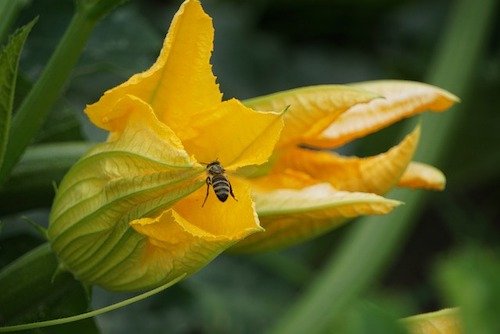
While pollinators like bees help with this, it’s also a good idea to hand pollinate your zucchini when the flowers bloom.
For one thing, the female flowers only open briefly, so you don’t want to miss the opportunity.
To pollinate zucchini, cut off a male flower, remove the petals to expose the stamen inside, and brush it against the inside of the female flower. Cotton swabs work too.
What zucchini variety does best in containers?
In the ground, zucchini can take up entire garden rows. So choosing a good compact bush variety is critical for success when growing zucchini in a container garden environment.
Good options include:
- Black Beauty
- Bush Baby
- Cue Ball
- Eight Ball
- Gold Rush
- Patio Star
- Raven
How and when to pick zucchini
Most summer squash mature in about 35-50 days, depending on the variety.
Once the plant starts to produce, harvest early and often to get the best-tasting zucchini and encourage lots of production.
Keep in mind that fruit on compact or dwarf varieties will be smaller than what you might be used to from the grocery store or farmers market.
In other words … don’t wait!
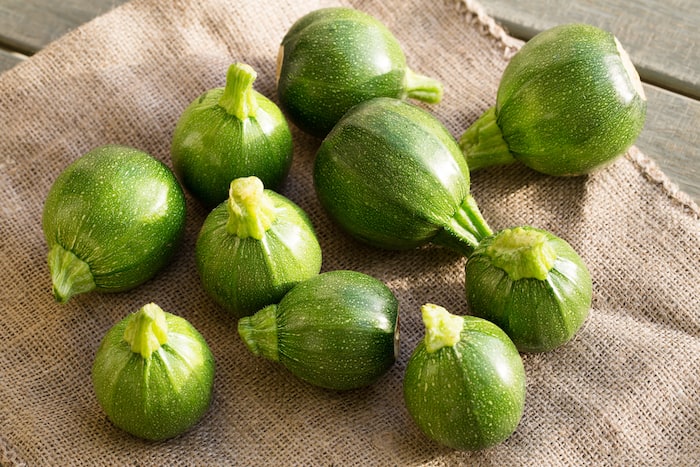
You want to harvest zucchini when it’s still small and the skin is shiny. Overgrown zucchini can be mealy, bitter and unappealing. So be sure to harvest early!
For compact varieties of long zucchini like Bush Baby and Patio Star, start harvesting when the fruit reaches about 4 inches long. Once the flowers pollinate, it can grow fast. So be sure to keep a close eye and pick before they get too long.
Round varieties like Eight Ball will only grow to be a few inches in diameter, so harvest when they’re about the size of a pool ball.
To harvest zucchini, simply cut the stem or twist the zucchini at the base.
Companion plants for zucchini in pots
Many gardeners and farmers believe in the power of companion planting. Situating certain plants next to each other (or far apart) can positively impact production, attract pollinators, and repel pests.
There are a lot of possible companion planting combinations for container gardens. For zucchini and other squash, good options include:
- Beans. As two of the Three Sisters, zucchini and beans are a classic combination and very complementary. Beans are a nitrogen fixer, which helps feed hungry zucchini.
- Dill, oregano and rosemary. Both herbs repel pests that can cause problems for zucchini, including cucumber beetles and cabbage moths.
- Mint. Deer and some other nibblers don’t love the mint smell, so it may help deter them from stealing your zucchini.
What are some ideas for cooking with zucchini?
It’s so worth it to have fresh home-grown zucchini in the kitchen! I use it all the time:

- In pasta sauce
- Marinated briefly in olive oil and fresh herbs like thyme, then roasted alone or with other veggies
- Grilled with fresh herbs
- Simmered in vegetable or Italian soup
- Layered in vegetarian lasagna
- Baked in a packet with fish and sprigs of fresh dill and thyme
- Sauteed with a little olive oil and parmesan cheese (my big kids actually loved this when they were little … my 4-year-old has not yet caught on)
- Cut fresh into sticks for dipping in ranch dressing
- Grated for zucchini bread
- Spiralized into zoodles
It’s super healthy (high in vitamins A and C) and has endless uses.
As I’ve said, zucchini is a big plant but can do very well in a container garden! You might just have more than you can use …
The main things to keep in mind: select a compact variety, find a full-sun location, and make sure to pollinate the flowers.
Planning your container garden? Here are some more ideas that might interest you:
- How to grow rosemary in a pot
- Growing okra in pots
- Grow catnip in pots from seed
- How to grow oregano in a pot
- Veggies that grow well together in containers
- How to grow dill in a pot
- Growing celery in pots
- How to grow cucumber in pots

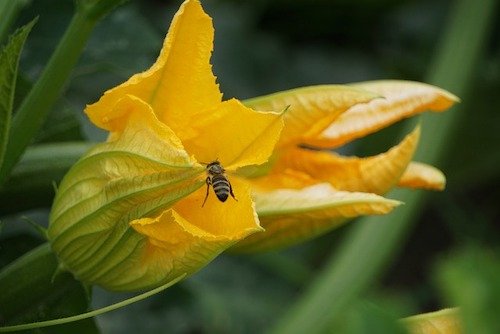
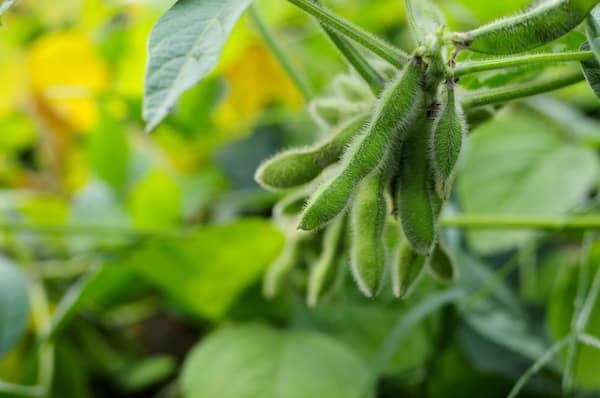
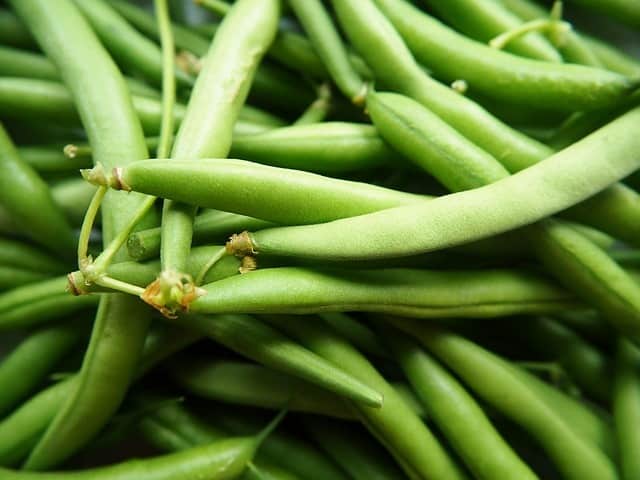
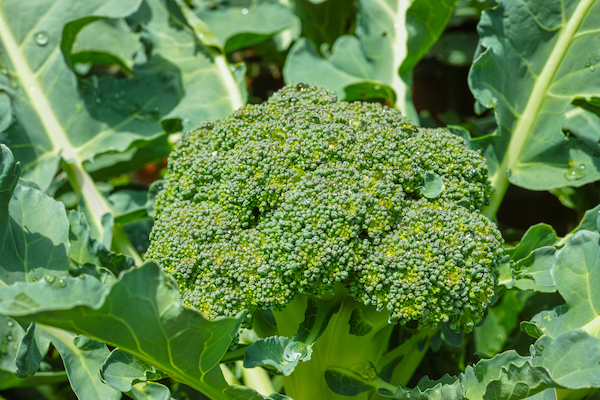
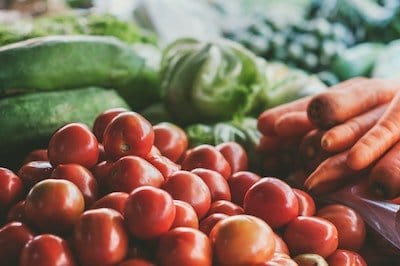
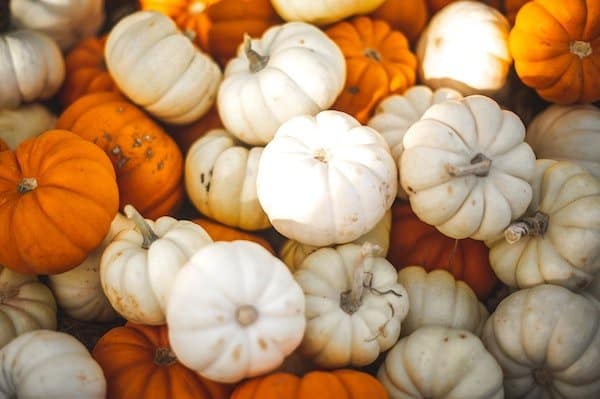
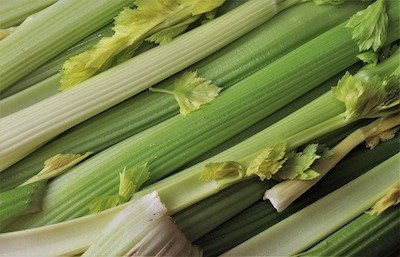
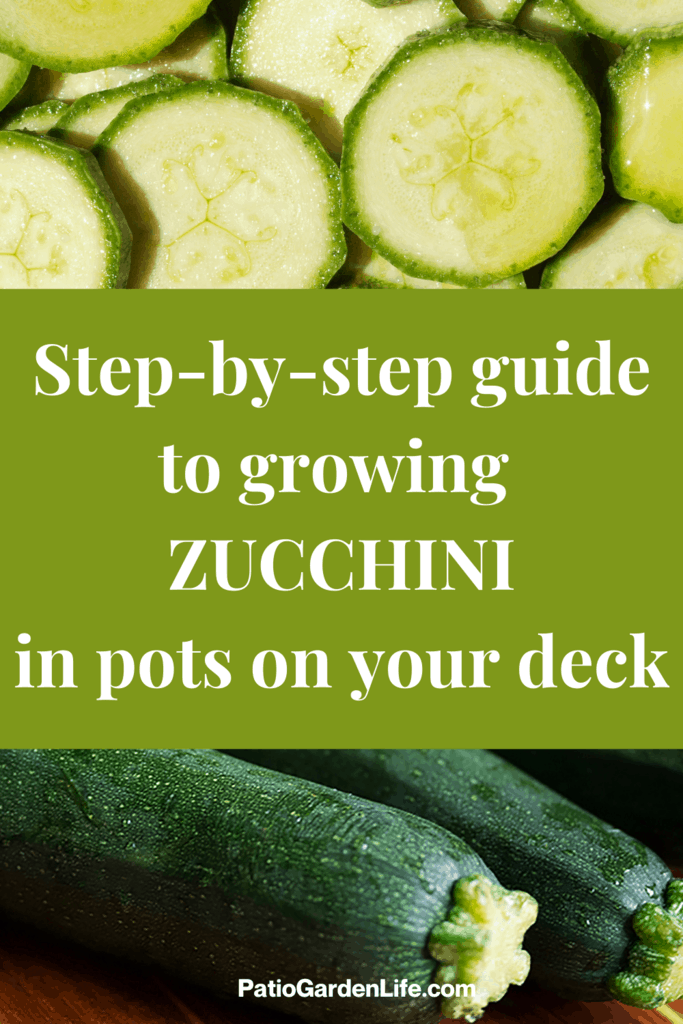
One Comment